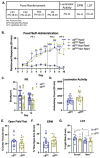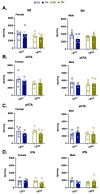Sex- and Genotype-Dependent Nicotine-Induced Behaviors in Adolescent Rats with a Human Polymorphism (rs2304297) in the 3'-UTR of the CHRNA 6 Gene
- PMID: 35328565
- PMCID: PMC8948824
- DOI: 10.3390/ijms23063145
Sex- and Genotype-Dependent Nicotine-Induced Behaviors in Adolescent Rats with a Human Polymorphism (rs2304297) in the 3'-UTR of the CHRNA 6 Gene
Abstract
In human adolescents, a single nucleotide polymorphism (SNP), rs2304297, in the 3'-UTR of the nicotinic receptor subunit gene, CHRNA6, has been associated with increased smoking. To study the effects of the human CHRNA6 3'-UTR SNP, our lab generated knock-in rodent lines with either C or G SNP alleles. The objective of this study was to determine if the CHRNA6 3'-UTR SNP is functional in the knock-in rat lines. We hypothesized that the human CHRNA6 3'-UTR SNP knock-in does not impact baseline but enhances nicotine-induced behaviors. For baseline behaviors, rats underwent food self-administration at escalating schedules of reinforcement followed by a locomotor assay and a series of anxiety tests (postnatal day (PN) 25-39). In separate cohorts, adolescent rats underwent 1- or 4-day nicotine pretreatment (2×, 30 μg/kg/0.1 mL, i.v.). After the last nicotine injection (PN 31), animals were assessed behaviorally in an open-field chamber, and brain tissue was collected. We show the human CHRNA6 3'-UTR SNP knock-in does not affect food reinforcement, locomotor activity, or anxiety. Further, 4-day, but not 1-day, nicotine exposure enhances locomotion and anxiolytic behavior in a genotype- and sex-specific manner. These findings demonstrate that the human CHRNA6 3'-UTR SNP is functional in our in vivo model.
Keywords: CHRNA6; adolescent; anxiety-like behavior; locomotor activity; pharmacogenetics.
Conflict of interest statement
The authors declare no conflict of interests.
Figures





Similar articles
-
Sub-chronic nicotine exposure influences methamphetamine self-administration and dopamine overflow in a sex-and genotype-dependent manner in humanized CHRNA6 3'-UTR SNP (rs2304297) adolescent rats.Front Pharmacol. 2024 Aug 14;15:1445303. doi: 10.3389/fphar.2024.1445303. eCollection 2024. Front Pharmacol. 2024. PMID: 39206256 Free PMC article.
-
Sex- and genotype-dependent nicotine plus cue-primed reinstatement is enhanced in adolescent Sprague Dawley rats containing the human CHRNA6 3'-UTR polymorphism (rs2304297).Front Psychiatry. 2023 Jan 10;13:1064211. doi: 10.3389/fpsyt.2022.1064211. eCollection 2022. Front Psychiatry. 2023. PMID: 36704741 Free PMC article.
-
Dopamine and Norepinephrine Tissue Levels in the Developing Limbic Brain Are Impacted by the Human CHRNA6 3'-UTR Single-Nucleotide Polymorphism (rs2304297) in Rats.Int J Mol Sci. 2024 Mar 26;25(7):3676. doi: 10.3390/ijms25073676. Int J Mol Sci. 2024. PMID: 38612487 Free PMC article.
-
Sex- and Genotype-Dependent Nicotine-Induced Behaviors in Adult Rats with a Human Polymorphism (rs2304297) in the 3'-UTR of the CHRNA6 Gene.Nicotine Tob Res. 2025 Jul 30:ntaf147. doi: 10.1093/ntr/ntaf147. Online ahead of print. Nicotine Tob Res. 2025. PMID: 40736212
-
Contribution of Variants in CHRNA5/A3/B4 Gene Cluster on Chromosome 15 to Tobacco Smoking: From Genetic Association to Mechanism.Mol Neurobiol. 2016 Jan;53(1):472-484. doi: 10.1007/s12035-014-8997-x. Epub 2014 Dec 5. Mol Neurobiol. 2016. PMID: 25471942 Review.
Cited by
-
Striatal Cholinergic Interneurons Control Physical Nicotine Withdrawal via Muscarinic Receptor Signaling.Adv Sci (Weinh). 2024 Dec;11(47):e2402274. doi: 10.1002/advs.202402274. Epub 2024 Nov 3. Adv Sci (Weinh). 2024. PMID: 39491887 Free PMC article.
-
Sub-chronic nicotine exposure influences methamphetamine self-administration and dopamine overflow in a sex-and genotype-dependent manner in humanized CHRNA6 3'-UTR SNP (rs2304297) adolescent rats.Front Pharmacol. 2024 Aug 14;15:1445303. doi: 10.3389/fphar.2024.1445303. eCollection 2024. Front Pharmacol. 2024. PMID: 39206256 Free PMC article.
-
Potential immunologic and prognostic roles of CHRNA6 in SCLC and pan-cancer.Heliyon. 2024 Sep 26;10(19):e38572. doi: 10.1016/j.heliyon.2024.e38572. eCollection 2024 Oct 15. Heliyon. 2024. PMID: 39398083 Free PMC article.
-
"Unraveling the role of CHRNA6, the neuronal α6 nicotinic acetylcholine receptor subunit".Receptors (Basel). 2025 Mar;4(1):1. doi: 10.3390/receptors4010001. Epub 2025 Jan 14. Receptors (Basel). 2025. PMID: 40331132 Free PMC article.
-
Sex- and genotype-dependent nicotine plus cue-primed reinstatement is enhanced in adolescent Sprague Dawley rats containing the human CHRNA6 3'-UTR polymorphism (rs2304297).Front Psychiatry. 2023 Jan 10;13:1064211. doi: 10.3389/fpsyt.2022.1064211. eCollection 2022. Front Psychiatry. 2023. PMID: 36704741 Free PMC article.
References
-
- US Department of Health and Human Services . The Health Consequences of Smoking—50 Years of Progress: A Report of the Surgeon General. US Department of Health and Human Services; Washington, DC, USA: 2014.
-
- NIDA “What Is the Scope of Tobacco, Nicotine, and e-Cigarette Use in the United States?” National Institute on Drug Abuse. [(accessed on 13 March 2022)];2022 February 8; Available online: https://nida.nih.gov/publications/research-reports/tobacco-nicotine-e-ci....
MeSH terms
Substances
Grants and funding
- 22RT-0103/Tobacco-Related Disease Research Program
- 21517/Brain and Behavior Research Grant
- R01, DA048899/NH/NIH HHS/United States
- UL1 TR001414 (SL)/University of California, Irvine (UCI) Institute for Clinical and Translational Sciences (ICTS) Pilot Studies Program (National Institute of Health, National Center for Advancing Translational Science (NIH, NCATS))
LinkOut - more resources
Full Text Sources
Miscellaneous

